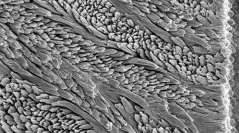Excavations carried out between 2001 and 2006 in the Early Pleistocene locality Senèze (Haute-Loire, France) yielded the fragment of a large upper incisor with anteriorly grooved enamel band, documenting a large-bodied rodent in Senèze for the first time. A thorough study of this incisor and particularly of its enamel microstructure led to its assignment to Hystrix refossa Gervais, 1852, despite the presence of longitudinal grooves which are usually considered as characteristic of the castorid genus Trogontherium Fischer von Waldheim, 1809 and which have not been noticed in Hystrix Linnaeus, 1758 so far. The presence of H. refossa is in accordance with the partly steppic environment previously documented in the Senèze locality.


 Geodiversitas
39 (4) - Pages 797-802
Geodiversitas
39 (4) - Pages 797-802